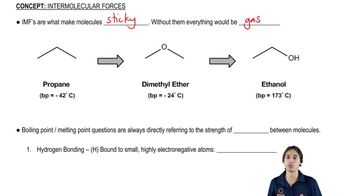List each set of compounds in order of increasing boiling point.
b. Octane, (CH3)3C—C(CH3)3 and CH3CH2C(CH3)2CH2CH2CH3
 Verified step by step guidance
Verified step by step guidance Verified video answer for a similar problem:
Verified video answer for a similar problem:



 3:08m
3:08mMaster How IMFs are related to melting and boiling points. with a bite sized video explanation from Johnny
Start learning